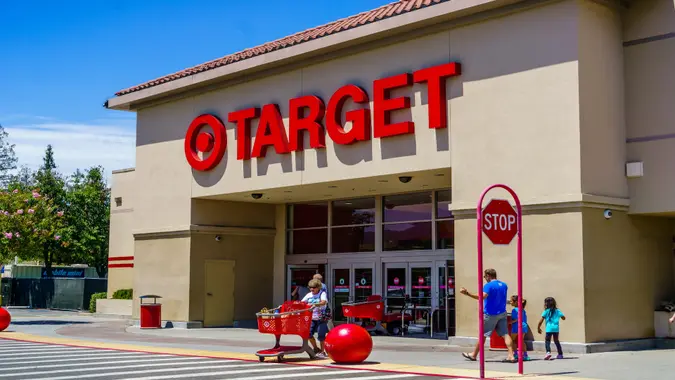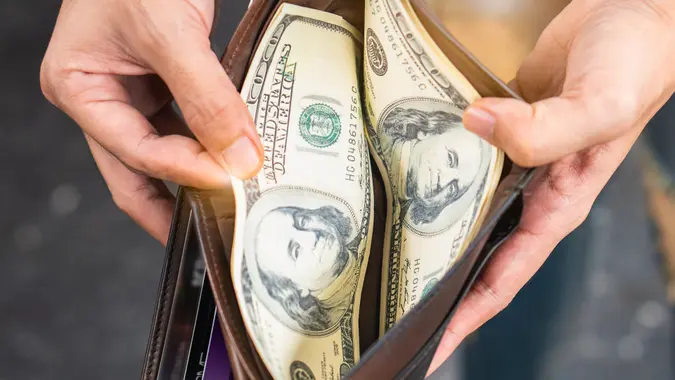Money Experts Julien and Kiersten Saunders Say You Should Do This Before the Holiday Season

Commitment to Our Readers
GOBankingRates' editorial team is committed to bringing you unbiased reviews and information. We use data-driven methodologies to evaluate financial products and services - our reviews and ratings are not influenced by advertisers. You can read more about our editorial guidelines and our products and services review methodology.

20 Years
Helping You Live Richer

Reviewed
by Experts

Trusted by
Millions of Readers
American households are carrying record amounts of debt, totaling nearly $18 trillion as of the second quarter of 2024 to the tune of about $104,000 per household. Credit card debt alone has reportedly surged to $1.1 trillion, or $6,500 per cardholder.
With the goal of inspiring better conversations about money, Julien and Kiersten Saunders host the “Rich & Regular” podcast and they recently offered some tips for paying off or paying down your debt ahead of the holidays.
“Credit card debt is as American as baseball, apple pie, hamburgers and hotdogs; it’s a way of life,” Julien Saunders said in a recent video. “It’s very easy to go into debt. It’s as common as the common cold.”
Debt takes an emotional and physical toll, and eliminating it should be celebrated as “one of the most meaningful, important, memorable moments of your life, not just your financial life, but your life in general,” according to Julien.
You have two primary strategies for reducing your debt ahead of the holidays: the snowball method and the avalanche method. Here they are, as explained by the “Rich & Regular” duo.
Pay Off Debt With the Snowball Method
Just like building a snowman, the snowball method involves starting small and watching your progress unfold.
“The psychology behind it is all about small wins, motivation, momentum,” Kiersten said. “The purpose is to get you going, get the party started.”
With the snowball method, you pay off the debt with the smallest balance first.
As an example, the duo highlighted a fictional woman named Tasha, a 32-year-old graphic designer with $20,000 in debt — including $1,000 on credit card A, with an 18% annual percentage rate; $3,000 on credit card B, with a 22% APR; a $12,000 car loan with a 6% APR; and a personal loan of $4,000, with a 10% APR.
In this case, Tasha should pay off credit card A first, which has the smallest balance.
“There is a lot of data that says this has the greatest impact for sustainable success,” Julien said. “It’s a lot, emotionally, to look at that $20,000, regardless of how much you earn. But when you start to make that kind of progress very early, people can start to see the light at the end of the tunnel.”
The snowball method is all about simple math — putting your debt balances in order, from least to greatest. The upside is you can quickly improve your credit score and feel good about making progress.
The downside, however, is that you may end up paying more overall when you don’t address your highest-interest debt first, and you may end up paying off your debt for a longer amount of time.
Or, Go With the Avalanche Method
The avalanche method involves taking a closer look at the details and paying off your debt with the highest interest rate first.
In Tasha’s case, this would be credit card B, with the 22% APR. While it would take longer to pay off the $3,000 balance than the $1,000 that the snowball method would tackle first, the avalanche method can facilitate a bigger initial win, and it will save you money in the long run — as long as you stick with it.
“In this method, you’re motivated by the money you’re saving,” Kiersten added. “It may take longer to see tangible progress, but there’s a prize at the end of the rainbow.”
If you compare these methods, you would pay less in interest with the avalanche method than with the snowball method. Nevertheless, both can be great options for reducing your debt ahead of the holidays and getting started on your financial New Year’s resolutions.
 Written by
Written by  Edited by
Edited by 

























